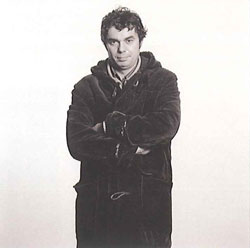Jorge Queiroz
Jorge Queiroz Lisboa ¶ 1966
 |
|
| Créditos fotográficos / Photographic credits: Abílio Leitão |
After a course at Ar.Co and a short stay at the Royal College of Art in London, he entered the New York School of Visual Arts in 1997, where he remained for the ensuing six years. ¶ In 2004 he moved to Berlin. His is a solid international projection, both in galleries and museums. Highlights of his career are his participation in the 2003 Venice biennial and the 2004 São Paulo biennial, in both occasions invited by the international curators, Francesco Bonami and Alfons Hug respectively. ¶ Working mainly with drawing, Jorge Queiroz steps out of a chiefly post-surrealist and post-symbolic scene to trace a path of his own. One recurring trait throughout his artistic approach is the absence of any titles or any kind of account of his work, an absence that points out to an a-linguistic universe whose nature is absolutely devoid of narrative linearity. In his dream-like landscapes one finds no organization, no hierarchy, and both the figure-background and the inside-outside relations are subverted. What remains is only a plethora of lines, blots, and marks that seem to turn about their own innards. By evoking the alchemical world of a Klein bottle, a self-closed bottle which turns its mouth into itself and that was used by Duchamp in his studies on the fourth dimension, we can say that Jorge Queiroz' drawings attempt at tapping into that same fourth dimension, which is a mathematical possibility as well as an old, undying aspiration. ¶ By the continuous employment of the inversion of content and container, a perception of obscure energy is expressed, an energy that has been ever-present in the past century in the arts and sciences. Whether through outrageous notions such as ectoplasm or telekinesis or through extraordinary evidence, for example in the form of radioactivity, magnetism or electricity, a powerful imaginary becomes embodied that is both fantastic and phantasmatic. Jorge Queiroz is part of this imaginary, and he has shown us proof that contemporaneity is far, far from reaching a notion of identity as Form, of the I-skin, or of classicism.
http://cvc.instituto-camoes.pt/biografias-en/jorge-queiroz-32737.html#sigFreeId2c32b11591


